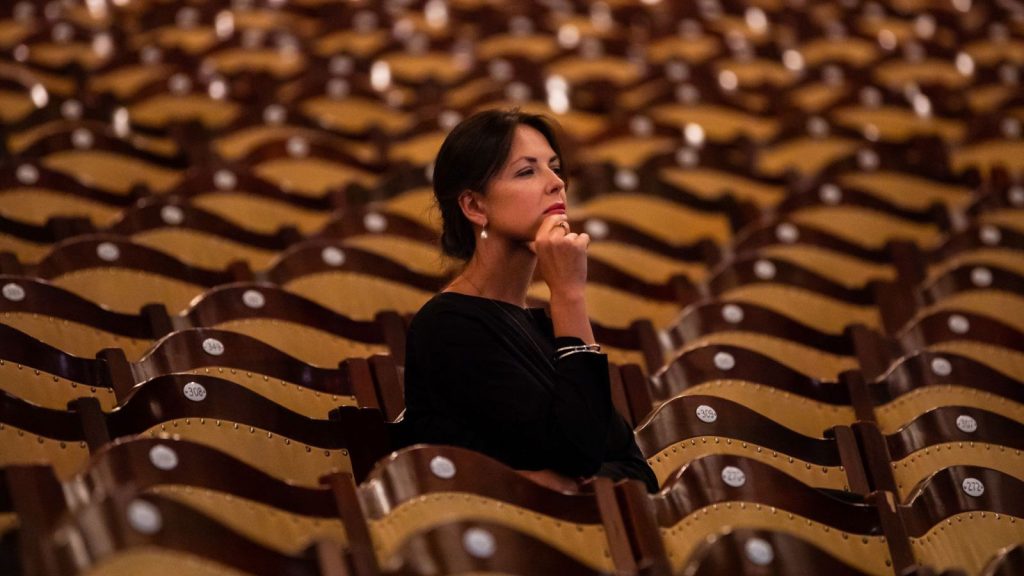Assembling an Organism. An interview with composer Justė Janulytė
Lithuanian composer Justė Janulytė watches and listens intently to the mysterious wonders of our reality. Born in Vilnius in 1982, Janulytė’s pieces explore time and space through the large-scale texturing of sound, moving between minimalism, spectralism, and electroacoustic music. Because of this, listeners have often compared listening to her music to being bathed in an overflow of sumptuous harmonies. Individual details are submerged in the characteristic intensity of a wave, where the expansion and blending of instrumentation creates the sensation of moving endlessly through an unpredictable current. Janulytė has also taken inspiration from the visual elements of the natural world, such as shifting clouds, falling snow, and the way blood circulates through the body. This focus allows her compositions to explore the density of sound and the themes of renewal and immortality.
I spoke to Janulytė about musical metamorphosis, Rothko’s color philosophy, and composing for the cinema.

VAN: How did you first become interested in music composition?
Justė Janulytė: Well, I was born and raised in Vilnius, and about 15 minutes from where I lived was the National M. K. Čiurlionis School of Art. This is the school where children from all over Lithuania come to learn and pursue careers as professional musicians, dancers, and artists. My parents enrolled me in the school when I was five years old, and it wasn’t long before I realized that I had absolute pitch. Here, I began my musical journey as a pianist; I also sang in a choir, and studied choir conducting as well as music theory. Part of the curriculum required us to take composition lessons, and as I progressed in the program, my professors encouraged me to dive deeper into composition. It was a gradual process. I never intended to become a composer when I started. 20 years later, I’ve been able to embrace and immerse myself in this calling.
Your approach to composition has been described as “monochromatic”: You produce musical transformations through the gradual layering of texture and register. It doesn’t matter if only one instrument is being used; you show that any instrument can remain in a constant state of metamorphosis. What attracts you to this approach?
To be honest, this approach to composition was another one of those happy accidents. When I was at the Lithuanian Music and Theatre Academy I was given a series of assignments that called for monochromatic instrumentation, meaning that only voices, or one kind of instrument, could be played throughout the duration of the piece: First for two pianos, then for four flutes, and finally, for my diploma piece, the assignment was to create a work for string orchestra. As I worked within the confines of those projects, I found that the technique of monochromatic instrumentation felt very comfortable for me.
A lot of this had to do with my experience singing in a professional choir. Standing in a mass of singers, I liked the feeling of everyone melting into one another; of becoming this single organism delivering a sound. When I first started composing, I was also inspired by the visual arts. At the time, a lot of visual elements were igniting my musical imagination, especially the monochrome paintings of Mark Rothko. Looking back, Rothko was hugely influential for me. His exploration of color inspired me in a very profound way. In my case, the overall structure of my compositions tends to stay the same. But the instrumentation changes; similar to how Rothko’s visual fields remain the same, but the colors change. So I think my approach to composition is similar to the color philosophy of Rothko.
Additionally, the mixtures of instruments and sounds in my work have become very important. As I moved along in my musical journey, I began incorporating other elements into my compositions and layering them; rather than just strings, I would include strings and voice, for example. When you layer sounds like this, it’s like stirring colors together. Soon, the listener loses their sense of what instrument is being played. They ask themselves, “Is this a string player, or a voice imitating the sound of an instrument?” This goes back to the idea of melting elements together so that you lose that sense of a single color, and just allow yourself to be immersed into the transformation of the piece.
How do you start a piece? Are there certain themes you find yourself being drawn to most as you compose?
Well, what tends to happen in the life of a composer is that you receive a commission, and it’s the commission that provides the parameters of what the instrumentation needs to be, for example orchestra or choir. And in these cases, you’re usually told what the duration of the piece needs to be. Although this may sound limiting, it’s the type of limitation that I find inspiring. Going back to Rothko’s color philosophy, every instrumentation has a different texture or color. The question is, how will I bring it to life with the instruments I’ve been given? In many ways, I think of this process like assembling an organism. The instrumentation functions a lot like the human body. In general, my compositional approach is very organic: I tend to derive my ideas from nature. I treat each group of instruments as an element from the natural world. And since in my mind I’m assembling a living organism, every element has to function properly in order to breathe life into it.
For example, in my piece “Sleeping Patterns,” there are 16 instruments which build seven groups. Each of these groups has a different pulsation of rhythm and they all overlap. The presentation mirrors the functionality of the human body. At any given moment, our eyes are blinking in a different tempo than our hearts. More and more, I’m drawn to creating these layers of different pulsations and how to bring them together to form a whole.
Also, my pieces are strongly connected to waves: starting from nothing, reaching some kind of dynamics, and then moving into silence. In my compositions, there are no sound attacks. This approach helps me to melt different groups of instruments together. And when I say a sound attack, I mean the characteristic moment that distinguishes a particular instrument; being able to say, “That’s the sound of an oboe.” But if we cut that sound attack, and instead start from nothing, then the sounds become difficult to distinguish: Am I hearing a voice, or is it a clarinet? I use this technique in all of my pieces, and the theme of waves is also something you can find throughout my work.
You also have a number of cinematic collaborations, including contributing music for two films by Latvian filmmaker and opera director Viestur Kairish. What was it like working on these films?
It was a great experience. I didn’t write a proper score for them: Kairish liked my music and ended up using compositions I had already created. He found the placement of the music within the scenes, which helped to create a stronger overlap of the visual, musical, and emotional dimensions. And I would love the opportunity to work on a film again. Although I would be interested in writing something for a specific film, I think the power of cinema enables already-composed works to find new meaning within the medium. For example, in Kairish’s film “January” there’s a funeral scene. It takes place in the countryside and there’s a procession of mourners. Here, the director used my piece “Unanime” for eight trumpets. When placed into the scene, the music sounded as if it had been created with a funeral connotation. It was as if the music had been written specifically to be played at funerals, which of course was never my intention. So, it’s great how cinema transforms music and enables it to exist in different contexts.
What keeps you motivated? Is there anything musically you haven’t accomplished yet, but would like to?
I’m interested in collaborating more with visual artists. In 2010, I worked with Italian video artist Luca Scarzella on a one-hour piece entitled “Sandglasses.” The composition is for four cellos and was performed by the Gaida Ensemble. The cellists are shrouded in transparent columns, and as they play, light trickles down the columns like grains of sand in an hourglass. The idea is that the viewer slowly loses their sense of time and space. I’m a visual person, and I like how the incorporation of visuals can probe and bring out the richness of a piece even further.
I would like to write longer pieces. I think it would be wonderful to have a full evening dedicated to a single work. As a listener, I love concerts where you get to experience just one piece. It allows you to go on this sonic journey, and feel as if you have been truly transported through something special. It’s an experience I always hope to deliver to my listeners.
[Based in Los Angeles, Matthew Vasiliauskas has covered the Eastern European culture and arts scene for journals such as All About Jazz. His fiction writing has appeared in publications including Conjunctions… More by Matthew Vasiliauskas]
Rėmėjai

